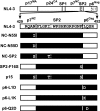Mutational analysis of the C-terminal gag cleavage sites in human immunodeficiency virus type 1
- PMID: 17634233
- PMCID: PMC2045408
- DOI: 10.1128/JVI.02496-06
Mutational analysis of the C-terminal gag cleavage sites in human immunodeficiency virus type 1
Abstract
Human immunodeficiency virus type 1 (HIV-1) Gag is expressed as a polyprotein that is cleaved into six proteins by the viral protease in a maturation process that begins during assembly and budding. While processing of the N terminus of Gag is strictly required for virion maturation and infectivity, the necessity for the C-terminal cleavages of Gag is less well defined. To examine the importance of this process, we introduced a series of mutations into the C terminus of Gag that interrupted the cleavage sites that normally produce in the nucleocapsid (NC), spacer 2 (SP2), or p6(Gag) proteins. Protein analysis showed that all of the mutant constructs produced virions efficiently upon transfection of cells and appropriately processed Gag polyprotein at the nonmutated sites. Mutants that produced a p9(NC/SP2) protein exhibited only minor effects on HIV-1 infectivity and replication. In contrast, mutants that produced only the p8(SP2/p6) or p15(NC/SP2/p6) protein had severe defects in infectivity and replication. To identify the key defective step, we quantified reverse transcription and integration products isolated from infected cells by PCR. All mutants tested produced levels of reverse transcription products either similar to or only somewhat lower than that of wild type. In contrast, mutants that failed to cleave the SP2-p6(Gag) site produced drastically less provirus than the wild type. Together, our results show that processing of the SP2-p6(Gag) and not the NC-SP2 cleavage site is important for efficient viral DNA integration during infection in vitro. In turn, this finding suggests an important role for the p9(NC/SP2) species in some aspect of integration.
Figures




Similar articles
-
Role of the C terminus Gag protein in human immunodeficiency virus type 1 virion assembly and maturation.J Gen Virol. 1995 Dec;76 ( Pt 12):3171-9. doi: 10.1099/0022-1317-76-12-3171. J Gen Virol. 1995. PMID: 8847526
-
Effects of human immunodeficiency virus type 1 transframe protein p6* mutations on viral protease-mediated Gag processing.J Gen Virol. 2006 Jul;87(Pt 7):2041-2046. doi: 10.1099/vir.0.81601-0. J Gen Virol. 2006. PMID: 16760407
-
Cumulative mutations of ubiquitin acceptor sites in human immunodeficiency virus type 1 gag cause a late budding defect.J Virol. 2006 Jul;80(13):6267-75. doi: 10.1128/JVI.02177-05. J Virol. 2006. PMID: 16775314 Free PMC article.
-
Sequential steps in human immunodeficiency virus particle maturation revealed by alterations of individual Gag polyprotein cleavage sites.J Virol. 1998 Apr;72(4):2846-54. doi: 10.1128/JVI.72.4.2846-2854.1998. J Virol. 1998. PMID: 9525604 Free PMC article.
-
Dominant Negative MA-CA Fusion Protein Is Incorporated into HIV-1 Cores and Inhibits Nuclear Entry of Viral Preintegration Complexes.J Virol. 2019 Oct 15;93(21):e01118-19. doi: 10.1128/JVI.01118-19. Print 2019 Nov 1. J Virol. 2019. PMID: 31413124 Free PMC article.
Cited by
-
A Truncated Nef Peptide from SIVcpz Inhibits the Production of HIV-1 Infectious Progeny.Viruses. 2016 Jul 7;8(7):189. doi: 10.3390/v8070189. Viruses. 2016. PMID: 27399760 Free PMC article.
-
Magnetically enhanced nucleic acid delivery. Ten years of magnetofection-progress and prospects.Adv Drug Deliv Rev. 2011 Nov;63(14-15):1300-31. doi: 10.1016/j.addr.2011.08.002. Epub 2011 Aug 26. Adv Drug Deliv Rev. 2011. PMID: 21893135 Free PMC article. Review.
-
Distinct nucleic acid interaction properties of HIV-1 nucleocapsid protein precursor NCp15 explain reduced viral infectivity.Nucleic Acids Res. 2014 Jun;42(11):7145-59. doi: 10.1093/nar/gku335. Epub 2014 May 9. Nucleic Acids Res. 2014. PMID: 24813443 Free PMC article.
-
Induced maturation of human immunodeficiency virus.J Virol. 2014 Dec;88(23):13722-31. doi: 10.1128/JVI.02271-14. Epub 2014 Sep 17. J Virol. 2014. PMID: 25231305 Free PMC article.
-
Features, processing states, and heterologous protein interactions in the modulation of the retroviral nucleocapsid protein function.RNA Biol. 2010 Nov-Dec;7(6):724-34. doi: 10.4161/rna.7.6.13777. Epub 2010 Nov 1. RNA Biol. 2010. PMID: 21045549 Free PMC article. Review.
References
-
- Bampi, C., A. Bibillo, M. Wendeler, G. Divita, R. J. Gorelick, S. F. Le Grice, and J. L. Darlix. 2006. Nucleotide excision repair and template-independent addition by HIV-1 reverse transcriptase in the presence of nucleocapsid protein. J. Biol. Chem. 281:11736-11743. - PubMed
-
- Berkowitz, R., J. Fisher, and S. P. Goff. 1996. RNA packaging. Curr. Top. Microbiol. Immunol. 214:177-218. - PubMed
Publication types
MeSH terms
Substances
Grants and funding
LinkOut - more resources
Full Text Sources
Other Literature Sources
Research Materials

